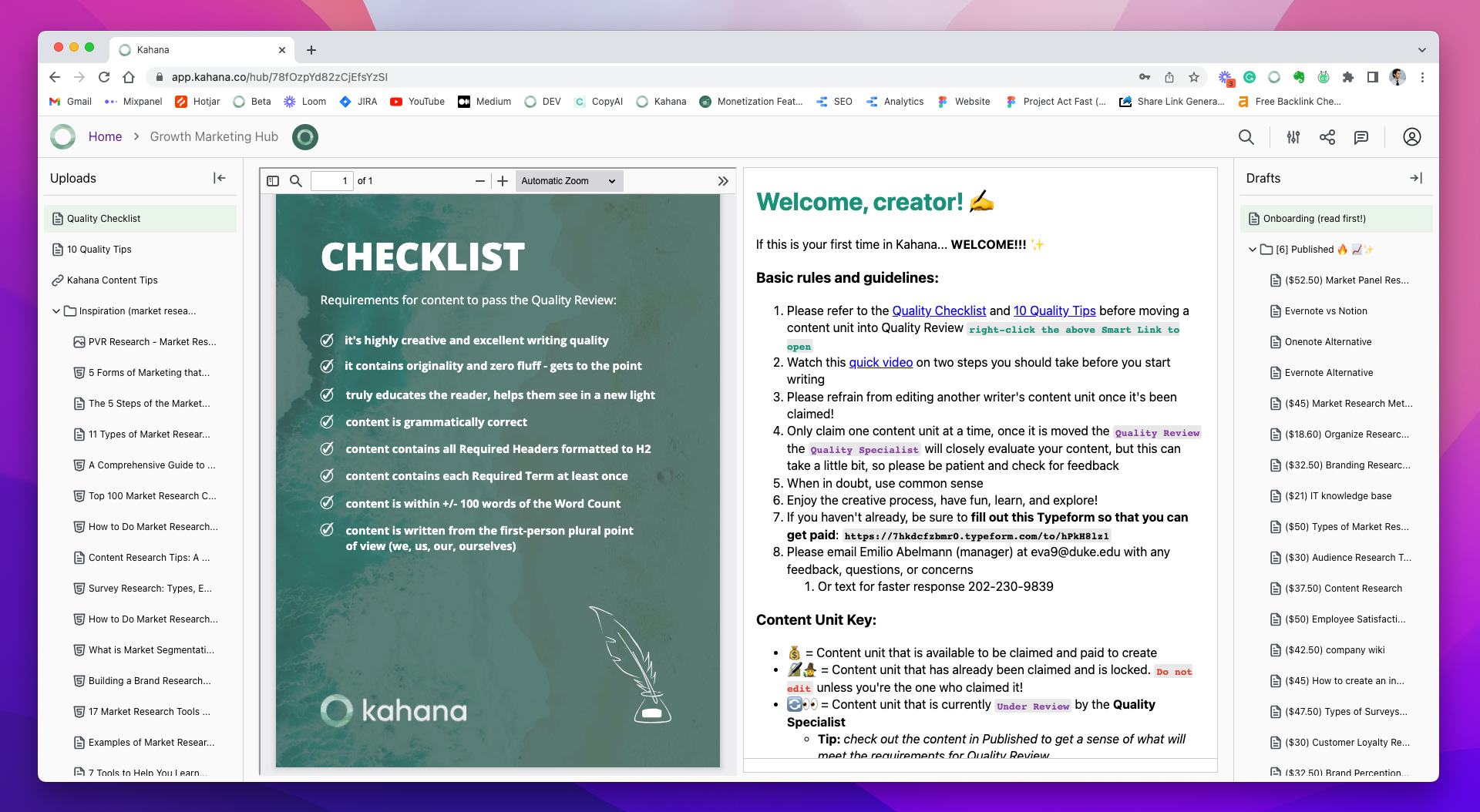Content Strategy Template, Examples, Framework, & Methods

Topics covered ✅
- Content strategy example
- Content strategy framework
- Content strategy plan
- Content strategy methods
- Content strategy for website
Planning a content strategy?
We’ve created a framework to help you earn respect, drive traffic, and generate revenue, through the distribution of compelling pieces of content.
Whenever you publish a piece of content, you’re signaling, not only to your customers but your competitors also, that you are an expert in your field and that you can offer valuable insight, so it’s essential to get this right.
1. Content Strategy 101: start with your target audience
When you begin thinking about your content strategy, start by imagining yourself as your target audience.
When you are looking to buy a product or service, you will naturally gravitate to reading blogs and thought leadership to make decisions.
However, with that in mind, how do you, as a business or influencer, go about building that trust with your target audience?
If you offer quality products that speak for themselves, that trust snowballs naturally through repeat sales, but how do you convince a first-time buyer that your business is the right one?
The high-level solution is to create a compelling piece of content that drives value and traffic while marrying your content ideas with keyword research from search engines.
2. Plan pieces of content that create value and traffic
Planning pieces of content that instill customer value and authority can often be easier said than done.
Successful content requires a deep understanding of your field as well as a unique perspective about your target audience that differentiates your narrative from your competitors.
Basically, you want to deliver a truly compelling piece of content.
What makes a compelling piece of content so valuable is the slow-building but immensely strong link that it forms between you, as the thought leader, and your target audience.
The reason this link is so powerful comes down to 2 simple points: customer value and authority.
You may want to consider leveraging various audience research tools at this stage.
Creating customer value
Initially, using a content strategy to drive traffic and business may seem like an ineffective and perplexing strategy.
Why should you spend time on content research and invest into content marketing while everyone benefits for free? Why not just run ads?
The answer is customer value. Building true customer value and loyalty is a surefire way to cultivate long-term relationships.
Customer value can be described as a feeling. It’s that sense your customers have deep down, that their questions about a certain topic, will be confidently answered by you and your piece of content.
Customer value is the knowledge you will undoubtedly provide them through a well-written, detailed, and thoughtful piece.
It’s about knowing that they can rely on you.
So, meet your customers where they are, learn their language (through interviews, surveys, etc), and reflect the spirit of what they value throughout your content strategy.
Leverage your authority to drive traffic
When you plan pieces of content, know that your voice should place you in a position of authority relative to your competitors, which is an incredibly prestigious achievement and comes with enormous benefits when done correctly.
Building a rapport with a target audience that values your output – a target audience that is excited to hear what you have to say – is a great way to drive traffic.
Traffic happens for a few reasons.
The first and most obvious reason is that in earning a level of authority relative to your peers, you will build up a loyal following who is excited to see your output and share it with others.
This is the type of high-value customer who you can eventually turn into a sale and once you have them regularly returning to your content, that’s when you can move them through the sales funnel from awareness and interest toward decision and purchase.
3. Marry your content ideas with keywords and search engines
The second reason authority can lead to greater site traffic is that once you have earned a level of recognition for the quality of your work, other sites will want to share your content, and backlinks are some of the most important factors that search engines use when ranking search results.
You may need to spend a sizeable amount of effort to achieve a large volume of traffic. However, reaching this level of authority makes subsequent future recognition more attainable.
To expedite the process, of driving traffic, do research on what keywords in your industry have a high volume and low competitive density. There are various tools out there that can help you with this, although there is no one solution.
When researching, we recommend gathering data from multiple sources.
While search engines and keywords are important…
Bear in mind that being seen as an authority on a topic means that the services that you provide are perceived as being great by association with your pieces of content.
Specifically, when it comes to B2B SEO, there is a special symbiotic relationship between your services and content strategy.
Outputting excellent content showcases your knowledge of your target audience’s pain points, who can safely assume that the services you provide will be equally good
The reverse is true in that providing excellent services can add credibility to your pieces of content.
4. “Listen” to searches and conduct an ongoing content analysis
Authority is the benefit you get from credibility. Above we talked about how authority is one element of your content strategy, but as we said you can’t get to that benefit if you are not a credible source.
Likewise, when you’re first starting out, people don’t know your expertise, so you have to prove it to them.
This will inevitably mean that your content will develop over time as you prove yourself.
Think of yourself as a “listener,” and let what you hear inform your content.
From the very beginning of your content strategy, you need to “listen” to searches and conduct ongoing content analysis in your industry, so you can have the most up-to-date understanding of what your target audience wants.
Evolving your content ideas based on learnings
At first, I think it’s important that you’re understanding and respectful of your audience not immediately giving credibility to your point of view as you’re starting out, but you can combat this by explaining thoroughly your thought process and reasoning behind your final conclusions, that way, they don’t have to believe you, they can see your working and come to their own conclusions.
Inevitably, as you build trust, you may have to walk through your position less, as people trust you more and you can refer back to your own previous work for credibility.
Sure, you can have one piece in particular that blows the reader away with its level of insight and analysis but authority doesn’t happen overnight, it’s something that you have to earn with consistently high-quality, valuable, and credible content.
5. Focus on adding value to drive content success
Value is the driving force behind why people are likely to visit your content. It’s also the reason they will stay with you.
Focus on adding value to drive sustainable content success.
Let’s say you’re about an already popular topic. Commenting on trends is a great way to benefit off of the back of a naturally popular subject and it can also show your audience that you’re aware of the surrounding market.
However, the value that you add to that discussion is what will make your content stand out from the rest.
Often blogs can rely too heavily on external data or research to have much value themselves, the reader might as well just go to the sources that you have used.
The goal is to be a thought leader, not a curator of facts and statistics. So, when creating your content, ask yourself, “what value can I add with my analysis and insight?”
Everybody has access to facts and data but not everyone is an expert like you so leverage that expertise to make truly valuable and insightful content.
6. Ask yourself questions to understand your target audience
Understanding your audience is crucial to your content strategy, as it governs so many aspects of the keywords you choose and the image that you want to project.
Here are some points to consider when working to understand your audience:
One of the first questions to think about is: what is my audience’s level of understanding of my topic?
The answer to this question changes your content strategy drastically if your audience is at a beginner level of understanding, it naturally places you as an educator, in a fundamentally different position than if you are writing to your peers with very high-level knowledge and you really have to use your expertise to set yourself apart.
Typically thought leadership is the latter of those options and is much more difficult than other educational content however the rewards are also much greater, as you are writing to a high-value audience.
Somewhat parallel to that, ask yourself: what do I want to get from my audience?
Have that goal very clear to yourself.
You’re probably not putting this amount of effort into creating a content strategy just for personal recognition.
There is likely some sort of transaction that you are aiming for in the end and so focus on your goal to transform this earned respect into transactions and what success in that looks like.
Understanding what you want from your engagement with your audience will drive the content you make.
7. Pay attention to where your target audience engages most
When building your content strategy, understand where your customers are in terms of the platforms where they like to see your content.
We have a comprehensive guide to a multichannel content strategy to learn more about this in-depth.
But essentially, you need to know where your customers spend their time and match the tone of those platforms in your output.
There is no good in investing in pieces of content if you’re not distributing them to where your audience is, and that’s why a multi-channel approach is so important.
A diversified approach allows you to reach many sectors of your audience through the use of different platforms.
Of course, this means you need to put in some time to understand how each platform works with respect to keywords and search terms.
All the above points are about your current and short-term future understanding of where your audience engages today or in the short-term future at least.
The bottom line
As you formulate your content strategy – be patient.
Consider how your audience will change over time.
- Will you have a cohort effect where some people grow out of your content but are replaced by new people?
- Will your audience grow and learn with you?
It’s inevitable your audience will change (and hopefully grow) but it is important that you are constantly aware of who makes up your audience and what the trajectory is.
Are you moving toward the size and type of audience you want?
Traffic may be growing, but is it growing with the correct target to meet your business goals?
So as you can see, building a content strategy requires a lot of expertise and skill.
The rewards for achieving content success, however, are enormous and will be a long-term driver of traffic to your site, which you can hope to capture and convert into sales.

Claim Free Content Strategy Template
This hub is ready-made and pre-populated with free tools, tips, and examples to help you improve your content strategy.

Talk with a Kahana representative
Fill out your information and a Kahana team representative will reach out to you. Have a simple question? Search our library of articles
